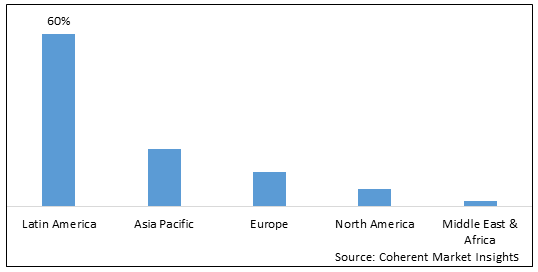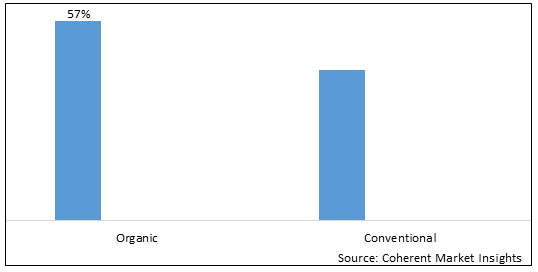Black Quinoa Market is estimated to be valued at USD 149.4 Mn in 2025 and is expected to reach USD 264.5 Mn in 2032, exhibiting a compound annual growth rate (CAGR) of 8.5% from 2025 to 2032.
Global Black Quinoa Market: Drivers
Rising Use of Black Quinoa to avoid Inflammation Diseases
Quinoa is low in calories, with only 160 calories per quarter-cup serving and only 2.5 grams of fat and six grams of protein. About 28% of the fatty acids in quinoa are oleic acid, a heart-healthy monounsaturated fat, and about 5% are alpha-linolenic acid, or ALA, an omega-3 fatty acid found most commonly in plants and linked to lower the risk of inflammation-related disease. Thereby, rising inflammatory diseases globally is expected to drive the global black quinoa market growth. For instance, according to World Health Organization (WHO), chronic diseases are ranked as the greatest hazard to human health. Moreover, WHO stated that in the U.S., the prevalence of disorders linked to chronic inflammation is expected to rise steadily over the next 30 years.
Increasing Government Support
Quinoa will be more readily available for purchase because more countries are now producing it. The government has supported research and development activities through the National Institute of Agricultural Research for supporting quinoa industry. Quinoa has the potential to introduce a new crop into the cropping system because of its adaptability to various environments and alleged nutritional benefits. For instance, in 2022, the Bolivian government launched a new quinoa export plan. This plan aims to increase the export of quinoa by 20% by 2025. The plan includes measures to improve the quality of quinoa, to promote quinoa in new markets, and to provide financial assistance to quinoa producers.
Global Black Quinoa Market: Restraints
Limited Availability of Black Quinoa
Limited supply of quinoa is one of the major restraint in the market, as these crops require certain cultivation environment. Hence, limited countries such as Peru and Bolivia produces quinoa crops. Regular increase in price of quinoa seeds, owing to high competition among the players is further expected to restrain the market growth. For instance, in 2022, global production of black quinoa was estimated to be around 10,000 tons. This is very small amount compared to the global production of other varieties of quinoa, which is estimated to be around 1 million tons.
Global Black Quinoa Market: Opportunity
Health Advantages of Natural and Organic Food Ingredients
Rising health advantages of super grains are expected to drive the market growth. Consumers' growing preference for wholesome, natural, and organic food ingredients that people can easily incorporate into their regular diets has increased demand for organic quinoa seeds. Because of its high nutritional value and abundance in dietary fibers, lysine, and other amino acids, organic quinoa seeds helps to prevent a wide range of illnesses.
Global Black Quinoa Market: Trends
Increasing Awareness Regarding Gluten-Free Products
Increasing popularity of the gluten-free diet and prevalence of gluten intolerance among the population are expected to boost demand for organic quinoa seeds. Furthermore, the crop of organic quinoa seeds adapts to various agro ecological regions. With 100 to 200 mm of rainfall, the organic quinoa plant can produce respectable yields while tolerating and resisting lack of soil moisture. The ease of growing organic quinoa seeds under current environmental conditions is expected to drive the market growth. The introduction of new products is one of the primary strategies employed by significant market players.
Black Quinoa Market Report Coverage
| Report Coverage | Details | ||
|---|---|---|---|
| Base Year: | 2024 | Market Size in 2025: | USD 149.4 Mn |
| Historical Data for: | 2020 To 2024 | Forecast Period: | 2025 To 2032 |
| Forecast Period 2025 to 2032 CAGR: | 8.5% | 2032 Value Projection: | USD 264.5 Mn |
| Geographies covered: |
|
||
| Segments covered: |
|
||
| Companies covered: |
The Quinoa Company, The J.M. Smucker Company, ARDENT MILLS, ADM Animal Nutrition, IMG Holdings Inc., Wunder Basket, Northern Quinoa Production Corporation, Kiwi Quinoa, The British Quinoa Company, and Organic Farmers Co. |
||
| Growth Drivers: |
|
||
| Restraints & Challenges: |
|
||
Uncover macros and micros vetted on 75+ parameters: Get instant access to report
Global Black Quinoa Market: Key Developments
In February 2023, Ardent Mills, the premier flour-milling and Ingredient Company, acquired Andean Naturals, a leading producer of black quinoa in the United States. This acquisition will help Ardent Mills to expand its black quinoa production and distribution capabilities.
In March 2023, The J.M. Smucker Company, is an American manufacturer of food and beverage products, launched a new line of black quinoa products. The new line includes black quinoa flakes, black quinoa pasta, and black quinoa granola. This launch is part of Smucker’s strategy to expand its presence in the healthy and convenient food categories.
In Aril 2023, Kiwi Quinoa launched a new line of black quinoa snacks. The new line includes black quinoa chips, black quinoa bars, and black quinoa popcorn. This launch is a part of Kiwi Quinoa’s strategy to expand its product offerings and reach new consumers.
In June 2022, The U.S. Department of Agriculture (USDA) launched a framework for the transformation of the food system that includes a US$ 300 million Organic Transition Initiative to offer farmers comprehensive support as they switch to organic farming.
Global Black Quinoa Market: Regional Analysis
Latin America is expected to hold a dominant position in the global market. Bolivia and Peru are a couple of the top nations that produce organic quinoa seeds. Asia Pacific will hold a significant share of the world market for organic quinoa seeds after Latin America. Increasing acceptance of healthy food ingredients is expected boost demand for organic quinoa seeds.
In Europe, there has been significant increase in demand for organic quinoa seeds. Huge demand for food items with high nutritional value and low calorie content is expected to drive the market growth.
Figure 1. Global Black Quinoa Market Share (%), By Region, 2025

To learn more about this report, Download Free Sample
Regionally, Latin America dominated the global black quinoa market in terms of revenue, in 2022, followed by Asia Pacific and Europe, respectively.
Global Black Quinoa Market: Segmentation
Global black quinoa market is segmented on the basis of type, application, and region. Further it is divided on the basis of Type, the market is segmented into organic and conventional and on the basis of Application, the market is segmented into food & beverages, animal feed, cosmetics, pharmaceuticals, and others.
Figure 2. Global Black Quinoa Market Share (%), By Type, 2025

To learn more about this report, Download Free Sample
On the basis of type, in 2025, the organic segment accounted for the largest market share of 57% in terms of value, followed by the conventional segment.
Global Black Quinoa Market: Impact of Coronavirus (COVID-19) Pandemic
Food is an essential commodity, and thus, there had been huge demand for food ingredients during the pandemic and post pandemic conditions, worldwide. Coronavirus (Covid-19) has majorly impacted the food & beverages industry, and has changed the dynamics of entire ecosystem including raw material suppliers, and supplying food ingredients. The supply chain has been disrupted by lockdowns in several countries, including Spain, China, and India, among others, and a halt to subsequent trade activities. Increasing spread of COVID-19 has mandated the manufacturers to deploy precautionary measures in their facilities including labors and plant controllers for screening and monitoring, and sanitizing the facilities
Global Black Quinoa Market: Key Companies
Key Companies operating in global black quinoa market are The Quinoa Company, The J.M. Smucker Company, ARDENT MILLS, ADM Animal Nutrition, IMG Holdings Inc., Wunder Basket, Northern Quinoa Production Corporation, Kiwi Quinoa, The British Quinoa Company, and Organic Farmers Co.
*Definition: The amaranth family includes the flowering plant known as quinoa. It is an herbaceous annual plant primarily grown for its edible seeds thatare superior to many grains in terms of protein, fiber, B vitamins, and minerals. Quinoa is a pseudocereal that has its origins in the Andean region of northern South America. It shares some botanical similarities with spinach and amaranth (family Amaranthus). It was initially consumed by humans, and used as animal feed in the Lake Titicaca region of Bolivia and Peru.
Share
Share
About Author
Yash Doshi is a Senior Management Consultant. He has 12+ years of experience in conducting research and handling consulting projects across verticals in APAC, EMEA, and the Americas.
He brings strong acumen in helping chemical companies navigate complex challenges and identify growth opportunities. He has deep expertise across the chemicals value chain, including commodity, specialty and fine chemicals, plastics and polymers, and petrochemicals. Yash is a sought-after speaker at industry conferences and contributes to various publications on topics related commodity, specialty and fine chemicals, plastics and polymers, and petrochemicals.
Missing comfort of reading report in your local language? Find your preferred language :
Transform your Strategy with Exclusive Trending Reports :
Frequently Asked Questions
Select a License Type
Joining thousands of companies around the world committed to making the Excellent Business Solutions.
View All Our Clients